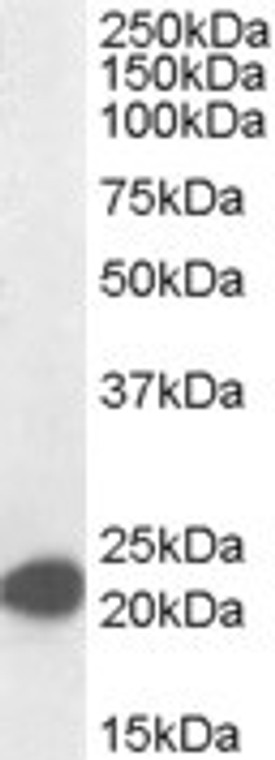| Host: |
Goat |
| Applications: |
Pep-ELISA/WB/IF/IHC |
| Reactivity: |
Human/Mouse/Rat/Dog/Cow |
| Note: |
STRICTLY FOR FURTHER SCIENTIFIC RESEARCH USE ONLY (RUO). MUST NOT TO BE USED IN DIAGNOSTIC OR THERAPEUTIC APPLICATIONS. |
| Short Description: |
Goat polyclonal antibody anti-MAX (C-Term) is suitable for use in ELISA, Western Blot, Immunofluorescence and Immunohistochemistry research applications. |
| Clonality: |
Polyclonal |
| Conjugation: |
Unconjugated |
| Isotype: |
IgG |
| Formulation: |
0.5 mg/ml in Tris saline, 0.02% sodium azide, pH7.3 with 0.5% bovine serum albumin. NA |
| Purification: |
Purified from goat serum by ammonium sulphate precipitation followed by antigen affinity chromatography using the immunizing peptide. |
| Concentration: |
0.5 mg/mL |
| Dilution Range: |
WB-0.01-0.03µg/mlIHC-10µg/mlIF-Expression of the protein seen in the cytoplasm and nuclei of A431 and U251 cells. 10µg/mlELISA-antibody detection limit dilution 1:32000. |
| Storage Instruction: |
Store at-20°C on receipt and minimise freeze-thaw cycles. |
| Gene Symbol: |
MAX |
| Gene ID: |
4149 |
| Uniprot ID: |
MAX_HUMAN |
| Immunogen Region: |
C-Term |
| Accession Number: |
NP_002373.3; NP_660087.1 |
| Specificity: |
This antibody is expected to recognize both reported isoforms (NP_002373.3; NP_660087.1). |
| Immunogen Sequence: |
EEPQSRKKLRMEAS |
| Post Translational Modifications | Reversible lysine acetylation might regulate the nuclear-cytoplasmic shuttling of specific Max complexes. |
| Function | Transcription regulator. Forms a sequence-specific DNA-binding protein complex with MYC or MAD which recognizes the core sequence 5'-CACGATG-3'. The MYC:MAX complex is a transcriptional activator, whereas the MAD:MAX complex is a repressor. May repress transcription via the recruitment of a chromatin remodeling complex containing H3 'Lys-9' histone methyltransferase activity. Represses MYC transcriptional activity from E-box elements. |
| Protein Name | Protein MaxClass D Basic Helix-Loop-Helix Protein 4Bhlhd4Myc-Associated Factor X |
| Database Links | Reactome: R-HSA-1362277Reactome: R-HSA-69202Reactome: R-HSA-69656Reactome: R-HSA-8953750 |
| Cellular Localisation | NucleusCell ProjectionDendrite |
| Alternative Antibody Names | Anti-Protein Max antibodyAnti-Class D Basic Helix-Loop-Helix Protein 4 antibodyAnti-Bhlhd4 antibodyAnti-Myc-Associated Factor X antibodyAnti-MAX antibodyAnti-BHLHD4 antibody |
Information sourced from Uniprot.org
12 months for antibodies. 6 months for ELISA Kits. Please see website T&Cs for further guidance









